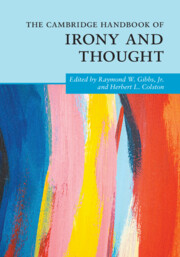Book contents
- The Cambridge Handbook of Irony and Thought
- Cambridge Handbooks in Psychology
- The Cambridge Handbook of Irony and Thought
- Copyright page
- Contents
- Contributors
- Part I Introduction
- Part II The Scope of Irony
- Part III Irony’s Impact
- 5 Irony as Social Work: Opposition, Expectation Violation, and Contrast
- 6 Rorty, Irony, and Neoliberalism
- 7 Irony and Its Consequences in the Public Sphere
- Part IV Irony in Linguistic Communication
- Part V Irony, Affect, and Related Figures
- Part VI Irony in Expressive, Nonlinguistic Media
- Index
- References
7 - Irony and Its Consequences in the Public Sphere
from Part III - Irony’s Impact
Published online by Cambridge University Press: 20 December 2023
- The Cambridge Handbook of Irony and Thought
- Cambridge Handbooks in Psychology
- The Cambridge Handbook of Irony and Thought
- Copyright page
- Contents
- Contributors
- Part I Introduction
- Part II The Scope of Irony
- Part III Irony’s Impact
- 5 Irony as Social Work: Opposition, Expectation Violation, and Contrast
- 6 Rorty, Irony, and Neoliberalism
- 7 Irony and Its Consequences in the Public Sphere
- Part IV Irony in Linguistic Communication
- Part V Irony, Affect, and Related Figures
- Part VI Irony in Expressive, Nonlinguistic Media
- Index
- References
Summary
This chapter explores the social, political, and legal implications of irony use. People do not simply employ irony for the sake of expressing ironical meanings alone, but use irony, especially in public spheres, to communicate a variety of pragmatic, or perlocutionary, messages. Many verbal ironies convey meanings that are strategically negotiated to affect different social, political, and legal outcomes. Irony often has significant, concrete consequences in real-life discourse contexts. Simpson presents various attested examples to exemplify how irony may be differently enacted in private and public spheres of communication, but can also be readily transferred, and sometimes transformed, from private conversations to larger public discussions. He appeals to critical discourse analysis as one possible approach to uncovering the social work that irony often accomplishes (e.g., power and ideology), and outlines some of the perils and pitfalls of irony in different discourse contexts (e.g., public sports conversations, legal discourse, politics, twitter). Simpson ends with a fascinating exploration of whether irony may be “the last refuge of the scoundrel,” a place inhabited by some politicians who appear to use irony as an option in any difficult situation where they must “apologize-or-deny-or-ironize.”
Keywords
- Type
- Chapter
- Information
- The Cambridge Handbook of Irony and Thought , pp. 112 - 128Publisher: Cambridge University PressPrint publication year: 2023

